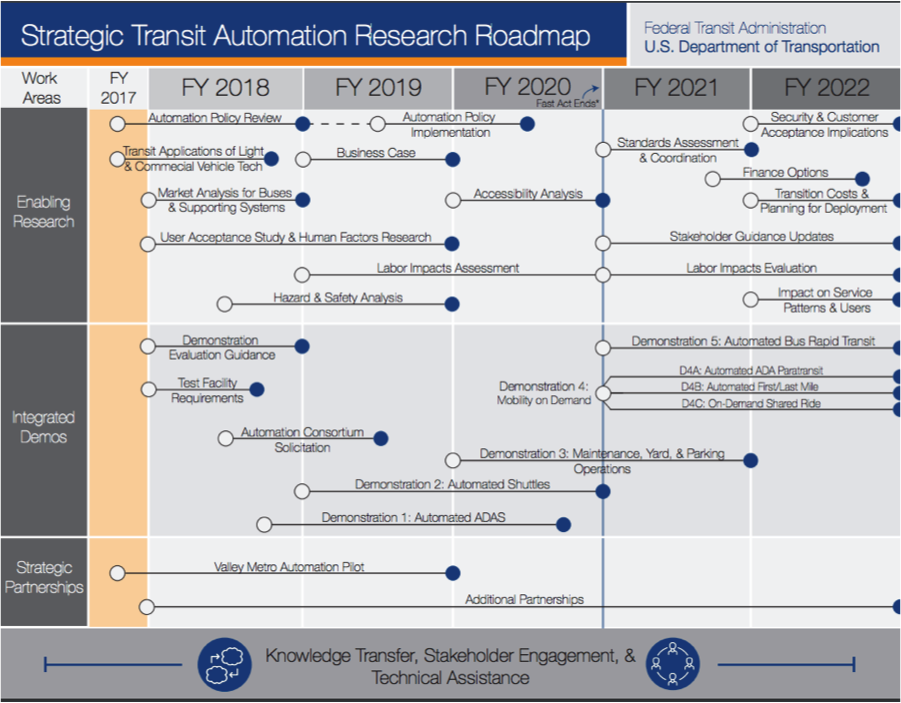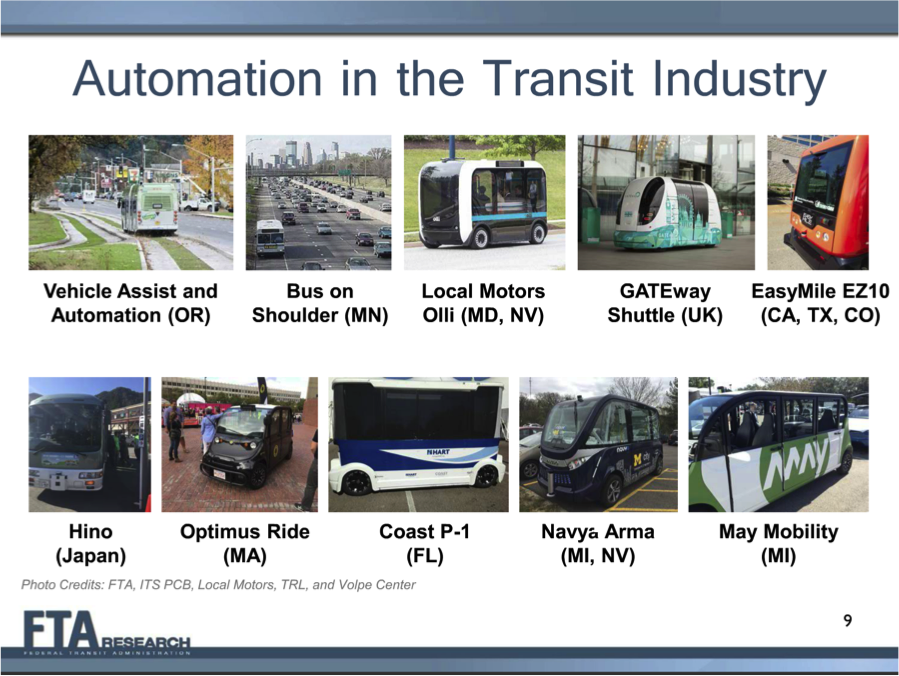December 8, 2017
On December 5, the Federal Transit Administration (FTA) unveiled its 5-year agenda for researching the potential benefits of vehicle automation for public transit. Dubbed the Strategic Transit Automation Research (STAR) Plan, it will serve as a guide for the agency and transit stakeholders through FY 2022.
Although automated vehicles (AVs) frequently grab headlines, most of the attention has been dedicated to how automation will impact personal vehicles and transportation network companies (TNCs) like Uber and Lyft – not trucks or buses. The consequence has been a glaring lack of coverage around manufacturers’ work on automated buses and how transit agencies could adopt them.
During an announcement webinar, an FTA official called STAR a “high risk, high reward” initiative that is intended to galvanize transit agencies and the industry. FTA has developed a three-pronged approach to reach some anticipated outcomes, such as spurring private sector investment and learning from real-world demonstrations.

(Source: FTA STAR Plan Roadmap)
STAR will focus solely on buses, a senior FTA official said. For the purposes of this research, FTA is broadly defining buses to include “traditional” buses (e.g., cutaways, 40 foot buses, and articulated buses) as well as innovative vehicle designs like driverless shuttles (e.g. EasyMile).
The official explained that rail automation has been excluded because “these systems are very different from buses” and the agency is waiting for that technology to mature first. However, FTA will use any lessons learned from the STAR program when it turns to rail automation in the future.
This plan is aligned with, and will be integrated into, USDOT’s ongoing efforts to develop regulatory certainty and guidance for stakeholders as vehicle automation technology matures.
In September 2016, the National Highway Traffic Safety Administration (NHTSA) released the Federal Automated Vehicle Policy Statement (FAVP), which provided guidance for AV manufacturers and best practices in state policies as the technology matures. Then, in alignment with the Obama Administration’s suggestion for annual revisions to the department’s AV policies, NHTSA released Automated Driving Systems 2.0: A Vision for Safety this September. This document provided manufacturers of passenger vehicles, trucks, and buses with guidance as they continue to develop AV technology.
As ETW reported last month, USDOT is now working on its next AV policy document, tentatively titled 3.0. According to senior USDOT officials, 3.0 will create a comprehensive framework for integrating AV technology in all forms of on-road transportation. These efforts will be led by a variety of modal administrations including FTA, through its work on STAR. This document will describe USDOT’s efforts to modernize standards and regulations in order to enable the deployment of AVs. USDOT may also introduce programs to speed up the integration of automation technology in buses, trucks, and passenger vehicles – as well as preparing the nation’s infrastructure for AVs.
FTA’s Roadmap to Automation
FTA has developed an ambitious roadmap for STAR that entails at least one – and sometimes three – demonstration projects per fiscal year through FY 2022, plus a slew of research initiatives to understand the effectiveness of automated buses, consumer acceptance, and potential workforce impacts, and many other topics.

(Source: FTA STAR Plan Roadmap)
For well over a year, FTA has been communicating with transit agencies and the private sector to learn about how public transit services could benefit from automation and, perhaps more importantly, how far it is from maturity.
As an FTA official noted, a handful of transit agencies are already experimenting with automated transit solutions. Yet the vast majority of these pilot programs are using small driverless shuttles for first/last-mile connections, rather than automating the functions of traditional buses.

(Source: FTA STAR Webinar – December 5, 2017)
This is partially due to the lack of market-ready technologies to automate buses, but also the inherent financial constraints in the public transit sector. While the average 12-year lifecycle of a bus is close to that of passenger vehicles, agencies face challenges in procurement, liability, and labor relations (among many others) that tend to make them more risk averse than car buyers.
As part of its early research for STAR, the FTA conducted benefit-cost analyses to quantify the opportunities and obstacles to transit automation. Notably, the benefit-cost analyses were limited to the financial costs, which excluded the social impacts (e.g., worker displacement) that are difficult to predict and quantify in advance.
FTA hopes to change this dynamic by supporting pilot projects that implement automated transit services and providing guidance for bus manufacturers and stakeholders. Through FY 2022, FTA will publish notice of funding opportunities (NOFOs) for seven demonstration project grants that will explore a variety of use cases:
- Integrated Demonstration 1 (FY 2018-2019): Implementing advanced driver assistance systems (ADAS) in transit buses (SAE Automation Level 1-2);
- Integrated Demonstration 2 (FY 2019-2020): Low-speed shuttle buses automation (e.g., circulator services, first/last-mile access to transit networks) (Level 4);
- Integrated Demonstration 3 (FY 2020-2021): Automation for maintenance and yard operations such as precision movement for fueling, maintenance, bus wash, automated remote parking and recall (Level 4);
- Integrated Demonstration 4a (FY 2021-2022): Automated ADA paratransit (Level 5);
- Integrated Demonstration 4b (FY 2021-2022): Automated first/last mile service (Level 5);
- Integrated Demonstration 4c (FY 2021-2022): On-demand shared ride service (Level 5);
- Integrated Demonstration 7 (FY 2021-2022): Automated bus rapid transit (BRT) service (Level 4).
Before taking automated buses to the streets and exposing them to the public, an FTA official noted that the agency must first test their safety and capabilities. As a result, FTA plans to construct an indoor/outdoor transit automation testing facility to support its integrated demonstration projects.
The agency is currently developing a set of requirements for the facility, which will be used to study the seven use cases for transit automation and other research areas outlined in STAR.
Roadblocks to Automation
Since FTA does not yet have a comprehensive set of regulations or guidance in place for automating transit services, it has already started researching potential policy barriers and incompatible regulations. In the process, FTA is examining how it can update its policies and, if necessary, create entirely new regulatory frameworks.
This research will culminate in FTA sending a set of recommendations to Congress for policy changes and updates to facilitate transit automation. FTA plans to send these recommendations in FY 2019 so that they can be considered in the next surface transportation bill when the FAST Act expires in 2020.
Introducing automated buses into transit operations can present a number of potential risks, which FTA has split into four categories: safety and security, operations and cost effectiveness, passenger experience, and equity.
The official highlighted equity risks in particular, describing a scenario where automated buses may not have on-board attendants and could be designed to only accept electronic payments. In this scenario, people without debit/credit cards – especially those who are already living in communities underserved by transit – would not be able to use the service since they would not be able to pay in cash.

(Source: FTA STAR Webinar – December 5, 2017)
Transit agencies must also prepare to confront a number of barriers to implementing automation technologies, including product availability, labor relations, financial constraints, and some transit agencies’ risk aversion.

(Source: FTA STAR Webinar – December 5, 2017)
Workforce resistance stands out in particular, as labor unions could mount opposition to agencies procuring automated buses if there are concerns of worker displacement. However, an FTA official suggested that the potential impact on bus drivers is “pretty unclear as of yet” and that even a self-driving bus may need an operator on board for fare collection, rider safety, and customer service.
On the other end, transit agencies will also need highly trained workforces capable of managing and maintaining automated bus fleets – workforces that do not exist yet.
As FTA rolls out this initiative in the coming years, it will research these and other issues and develop guidance for agencies as they navigate the new world of automated transit services.
“We really want to be a clearinghouse, a one-stop shop,” an FTA official said.
The roadmap for the STAR Plan and ongoing updates from FTA can be accessed here.







